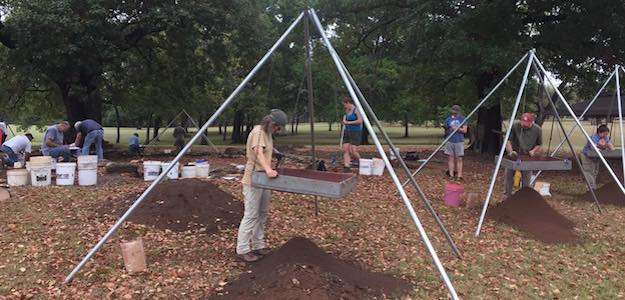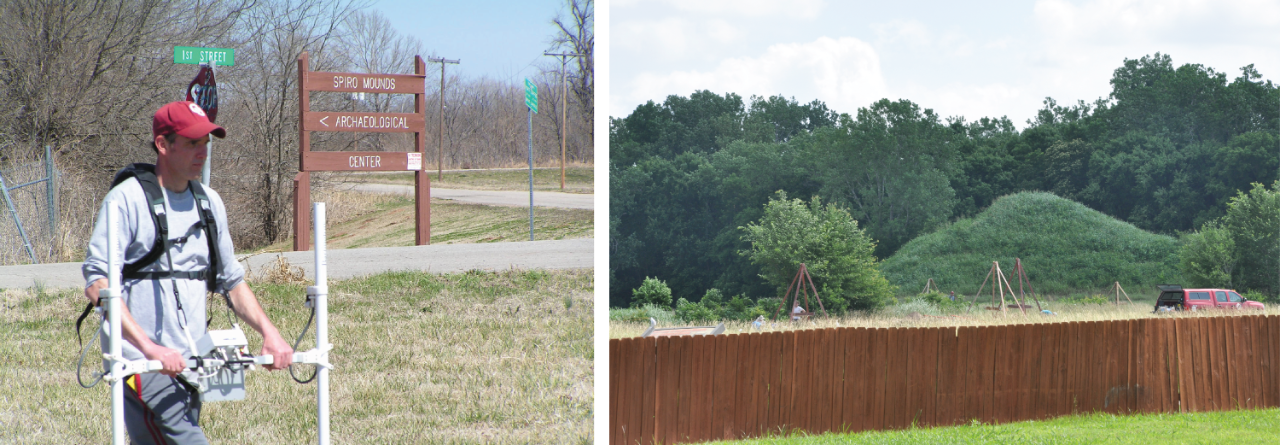Current Research Projects
Researchers at the Oklahoma Archeological Survey undertake a number of projects each year in order to better understand Oklahoma's past. Below we have highlighted a few of our current research projects.

Ravenscroft Bison Kill, Beaver County, OK
Ravenscroft is a 9,300 year old bison kill site. The site consists of two arroyos. Each arroyo contains separate bison kill episodes. The first arroyo contains up to two bison kill episodes dating between 9,000 and 9,200 radiocarbon years ago. The second arroyo has at least two components dating between 9,300 and maybe 9,350 years ago. All kill events are of winter herds driven up the arroyo to the steep dead-end. Animals could not escape. The high walls kept them trapped until hunters, perched on the arroyo rim, speared them. The cultures attributed with these kills were possibly related to either Plainview, Scottsbluff, or perhaps early Frederick/Allen. The only complete projectile point is a beautiful Dakota quartzite lanceolate form. So far, we have analyzed at least 25 animals from our excavations. The bison are smaller than the Bison antiquus at the Cooper site, yet larger than a modern Bison bison. This intermediate form is not supposed to exist (but don’t tell that to the Paleoindians!). Excavation has halted at this site so that we can finish the analysis.

Spiro Landscape Archaeological Project
The Spiro Landscape Archaeological Project (SLAP), begun in 2011, is a joint effort between researchers at the University of Oklahoma and University of Arkansas. Briefly put, SLAP's goals are to more fully understand the nature and extent of non-mound habitation at and around the Spiro Mounds site in eastern Oklahoma through geophysical survey and targeted archaeological excavations. To date, we have surveyed over 30 hectares at and around Spiro Mounds state park with gradiometers. Selected areas have also been surveyed with electrical resistance, magnetic susceptibility, conductivity, and ground-penetrating radar. Gradiometer survey revealed the presence of at least 70 structure-like anomalies in the areas surrounding Craig Mound. Several of these were corroborated by multiple technologies. Four of these anomalies were at risk of erosion from the man-made creek that runs through the site. In cooperation with the US Army Corps of Engineers, the Caddo Nation, the Wichita and Affiliated Tribes, and the Oklahoma Historical Society, we entered into a Memorandum of Agreement to excavate these features and obtain valuable archaeological data. A total of eight weeks of excavations took place in October 2013 and through the University of Oklahoma archaeological field school during the summer of 2014. All four anomalies are most likely the remnant of hastily-built prehistoric buildings, although our analysis is ongoing. Follow us on Facebook!

Fort Gibson, Muskogee County, OK
Between 2007 and 2009, staff from the Oklahoma Historical Society and Oklahoma Archeological Survey and volunteers from the Oklahoma Anthropological Society, conducted four separate series of excavations along portions of the original stockade. During these excavations, we located stone foundation walls, hearths, and an additional structure outside the walls that proved to be a latrine (also known as a privy). While it does initially sound strange to excavate a privy, during the 19th century, these features also served as garbage receptacles, frequently containing household garbage deposited over a long period. This makes them especially interesting to archaeologists. Probably the most exciting artifact recovered from the privy was an early 19th century officer’s sword. The sword, made of brass and iron with a wooden hilt, was in a poor state of preservation after sitting in the lime environment of the privy soil for nearly 200 years.
The privy yielded other important garbage, including the remains of numerous wine, beer, and liquor bottles, a near-complete set of broken tea cups, multiple chamber pots, and even the imprints of newspaper (yuck!) on bricks of lime. These artifacts indicate the privy was used over more than 30 years, and show the changes in English-made ceramics over that period. We are still in the process of examining artifacts from various contexts in order to better understand life at this frontier fort. A graduate student will likely be using artifacts from the privy for a masters’ thesis project, so check back for future developments!


